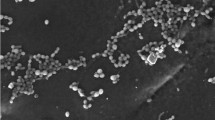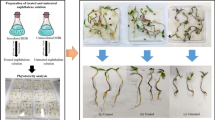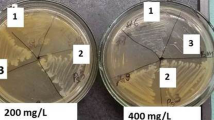Abstract
Chlorpyrifos (CPF) is moderately persistent in soils. In our study, microcalorimetry was introduced for the first time to explore the acute toxic effect of CPF on a Pseudomonas strain in sterilized soil. Firstly, it was determined by microcalorimetry that P. putida failed to degrade CPF. Then the acute toxicity of increasing concentrations of CPF to P. putida was determined by its temporal effects on metabolism and counts of colony forming units. Results revealed that the increase of CPF concentration could induce a decrease of the growth rate constant (k) and the total thermal effect (Q T), representing an inhibiting action on P. putida. In addition, the colony forming units (CFU) for P. putida were counted. Results showed that the number of P. putida decreased with increasing CPF dose after 18 h of incubation in sterilized soil. Interestingly, the trend of the number of CFU was similar to the growth rate constant k, whereas the trend became irregular after 36 h of incubation. This indicated that P. putida resisted and also expresses high metabolic activity during the exponential growth phase of 18 h; thereafter the microorganisms showed a certain adaptation, even declining in number and activity.





Similar content being viewed by others
References
Aagot N, Nybroe O, Nielsen P, Johnsen K (2001) An altered Pseudomonas diversity is recovered from soil by using nutrient-poor Pseudomonas-selective soil extract media. Appl Environ Microbiol 67:5233–5239
Anderson JPE, Domsh KH (1978) A physiological method for the quantitative measurement of microbial biomass in soils. Soil Biol Biochem 10:215–221
Anwar S, Liaquat F, Khan QM, Khalid ZM, Iqbal S (2009) Biodegradation of chlorpyrifos and its hydrolysis product 3,5,6-trichloro-2-pyridinol by Bacillus pumilus strain C2A1. J Hazard Mater 168:400–405
Barja I, Núñez L (1999) Microcalorimetric measurements of the influence of glucose concentration on microbial activity in soils. Soil Biol Biochem 31:441–447
Barros N, Feijóo S, Balsa R (1997) Comparative study of the microbial activity in different soils by the microcalorimetric method. Thermochim Acta 296:53–58
Barros N, Salgado J, Feijóo S (2007) Calorimetry and soil. Thermochim Acta 458:11–17
Carpenter RJ, Hartzell JD, Forsberg JA, Babel BS, Ganesan A (2008) Pseudomonas putida war wound infection in a US Marine: a case report and review of the literature. J Infect 56:234–240
Chen HL, Yao J, Wang F, Choi MMF, Bramanti E, Zaray G (2009) Study on the toxic effects of diphenol compounds on soil microbial activity by a combination of methods. J Hazard Mater 167:846–851
Cochran RC, Kishiyama J, Aldous C, Carr WC, Pfeifer KF (1995) Chlorpyrifos—hazard assessment based on a review of the effects of short-term and long-term exposure in animals and humans. Food Chem Toxicol 33:165–172
Critter SAM, Simoni JD, Airoldi C (1994) Microcalorimetric study of glucose degradation in some Brazilian soils. Thermochim Acta 232:145–154
Critter SAM, Freitas SS, Airoldi C (2001) Calorimetry versus respirometry for the monitoring of microbial activity in a tropical soil. Appl Soil Ecol 18:217–227
Critter SAM, Freitas SS, Airoldi C (2002) Comparison between microorganism counting and a calorimetric method applied to tropical soils. Thermochim Acta 394:133–144
Eaton DL, Daroff RB, Autrup H, Bridges J, Buffler P, Costa LG, Coyle J, McKhann G, Mobley WC, Nadel L, Neubert D, Schulte-Hermann R, Spencer PS (2008) Review of the toxicology of chlorpyrifos with an emphasis on human exposure and neurodevelopment. Crit Rev Toxicol 38:1–125
Fang H, Yu YL, Wang XG, Chu XQ, Pan XD, Yang XE (2008) Effects of repeated applications of chlorpyrifos on its persistence and soil microbial functional diversity and development of its degradation capability. Bull Environ Contam Toxicol 81:397–400
Fischer H, Meyer A, Fischer K, Kuzyakov Y (2007) Carbohydrate and amino acid composition of dissolved organic matter leached from soil. Soil Biol Biochem 39:2926–2935
Fradette S, Rho D, Samson R, Leduy A (1994) Microcalorimetry as a diagnostic and analytical tool for the assessment of biodegradation of 2,4-D in a liquid-medium and in soil. Appl Microbiol Biotechnol 42:432–439
Fukuto TR (1990) Mechanism of action of organophosphorus and carbamate insecticides. Environ Health Perspect 87:245–254
Kale SP, Carvalho FP, Raghu K, Sherkhane PD, Pandit GG, Mohan Rao A, Mukherjee PK, Murthy NBK (1999) Studies on degradation of 14C-chlorpyrifos in the marine environment. Chemosphere 39:969–976
Kiliç Z, Acar O, Ulasan M, Ilim M (2002) Determination of lead, copper, zinc, magnesium, calcium and iron in fresh eggs by atomic absorption spectrometry. Food Chem 76:107–116
Lakshmi CV, Kumar M, Khanna S (2009) Biodegradation of chlorpyrifos in soil by enriched cultures. Curr Microbiol 58:35–38
Mehlich A (1984) Mehlich 3 soil test extractant: a modification of Mehlich 2 extractant. Commun Soil Sci Plan 15:1409–1416
Mileson BE, Chambers JE, Chen WL, Dettbarn W, Ehrich M, Eldefrawi AT, Gaylor DW, Hamernik K, Hodgson E, Karczmar AG, Padilla S, Pope CN, Richardson RJ, Saunders DR, Sheets LP, Sultatos LG, Wallace KB (1998) Common mechanism of toxicity: a case study of organophosphorus pesticides. Toxicol Sci 41:8–20
Moorman TB (1989) A review of pesticide effects on microorganisms and microbial processes related to soil fertility. J Prod Agric 2:14–23
Mosqueda G, Ramos-González M-I, Ramos JL (1999) Toluene metabolism by the solvent-tolerant Pseudomonas putida DOT-T1 strain, and its role in solvent impermeabilization. Gene 232:69–76
Murray RT, von Stein C, Kennedy IR, Sanchez-Bayo F (2001) Stability of chlorpyrifos for termiticidal control in six Australian soils. J Agric Food Chem 49:2844–2847
Murray RK, Granner DK, Mayes PA, Rodwell VW (2003) Harper’s illustrated biochemistry. McGraw-Hill, New York, NY
Núñez-Regueira L, Rodríguez-Añón JA, Proupín-Castiñeiras J, Núñez-Fernández O (2006) Microcalorimetric study of changes in the microbial activity in a humic Cambisol after reforestation with eucalyptus in Galicia (NW Spain). Soil Biol Biochem 38:115–124
Omar SA, Abdel-Sater MA (2001) Microbial populations and enzyme activities in soil treated with pesticides. Water Air Soil Pollut 127:49–63
Pablo F, Krassoi FR, Jones PRF, Colville AE, Hose GC, Lim RP (2008) Comparison of the fate and toxicity of chlorpyrifos—Laboratory versus a coastal mesocosm system. Ecotoxicol Environ Safe 71:219–229
Pandey S, Singh DK (2004) Total bacterial and fungal population after chlorpyrifos and quinalphos treatments in groundnut (Arachis hypogaea L.) soil. Chemosphere 55:197–205
Prado AGS, Airoldi C (2000) Effect of the pesticide 2,4-D on microbial activity of the soil monitored by microcalorimetry. Thermochim Acta 349:17–22
Prado AGS, Airoldi C (2001) Microcalorimetry of the degradation of the herbicide 2,4-D via the microbial population on a typical Brazilian red Latosol soil. Thermochim Acta 371:169–174
Prado AGS, Airoldi C (2002) The toxic effect on soil microbial activity caused by the free or immobilized pesticide diuron. Thermochim Acta 394:155–162
Racke KD (1993) Environmental fate of chlorpyrifos. Rev Environ Contam Toxicol 131:1–150
Reinecke SA, Reinecke AJ (2007) The impact of organophosphate pesticides in orchards on earthworms in the Western Cape, South Africa. Ecotoxicol Environ Safe 66:244–251
Richardson RJ (1995) Assessment of the neurotoxic potential of chlorpyrifos relative to other organophosphorus compounds: a critical review of the literature. J Toxicol Environ Health 44:135–165
Rogers MR, Stringfellow WT (2009) Partitioning of chlorpyrifos to soil and plants in vegetated agricultural drainage ditches. Chemosphere 75:109–114
Singh BK, Walker A, Wright DJ (2002) Persistence of chlorpyrifos, fenamiphos, chlorothalonil, and pendimethalin in soil and their effects on soil microbial characteristics. Bull Environ Contam Toxicol 69:181–188
Singh BK, Walker A, Morgan JAW, Wright DJ (2004) Biodegradation of chlorpyrifos by Enterobacter strain B-14 and its use in bioremediation of contaminated soils. Appl Environ Microbiol 70:4855–4863
Wainwright M (1978) A review of the effects of pesticides on microbial activity in soils. Eur J Soil Sci 29:287–298
Wang F, Yao J, Chen HL, Zhou Y, Chen YJ, Chen HY, Gai N, Zhuang RS, Tian L, Maskow T, Ceccanti B, Trebse P, Zaray G (2009) Microcalorimetric measurements of the microbial activities of single- and mixed-species with trivalent iron in soil. Ecotoxicol Environ Safe 72:128–135
Yao J, Tian L, Wang YX, Djah A, Wang F, Chen HL, Su CL, Zhuang RS, Zhou Y, Choi MMF, Bramanti E (2008) Microcalorimetric study the toxic effect of hexavalent chromium on microbial activity of Wuhan brown sandy soil: An in vitro approach. Ecotoxicol Environ Safe 69:289–295
Acknowledgements
This work was supported in part by grants from National Outstanding Youth Research Foundation of China (40925010), International Joint Key Project from National Natural Science Foundation of China (40920134003), National Natural Science Foundation of China (40673065, 40873060), and International Joint Key Project from Chinese Ministry of Science and Technology (2009DFA92830), and the 111 Project (B08030).
Author information
Authors and Affiliations
Corresponding author
Rights and permissions
About this article
Cite this article
Chen, H., Yao, J., Wang, F. et al. Investigation of the Acute Toxic Effect of Chlorpyrifos on Pseudomonas putida in a Sterilized Soil Environment Monitored by Microcalorimetry. Arch Environ Contam Toxicol 58, 587–593 (2010). https://doi.org/10.1007/s00244-009-9404-x
Received:
Accepted:
Published:
Issue Date:
DOI: https://doi.org/10.1007/s00244-009-9404-x




